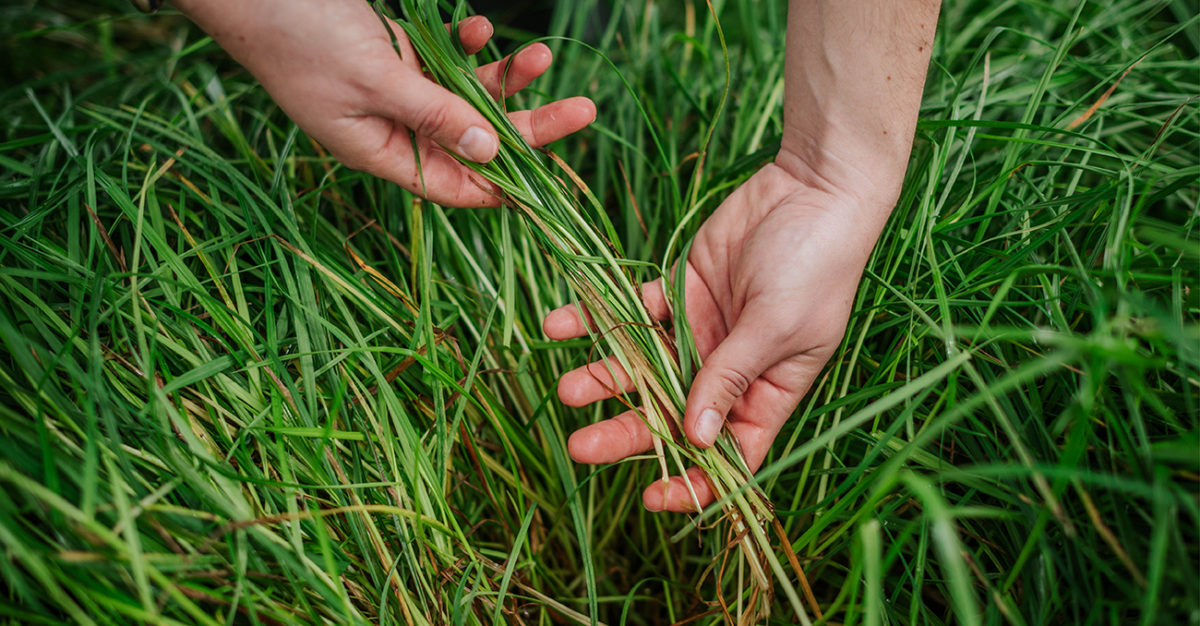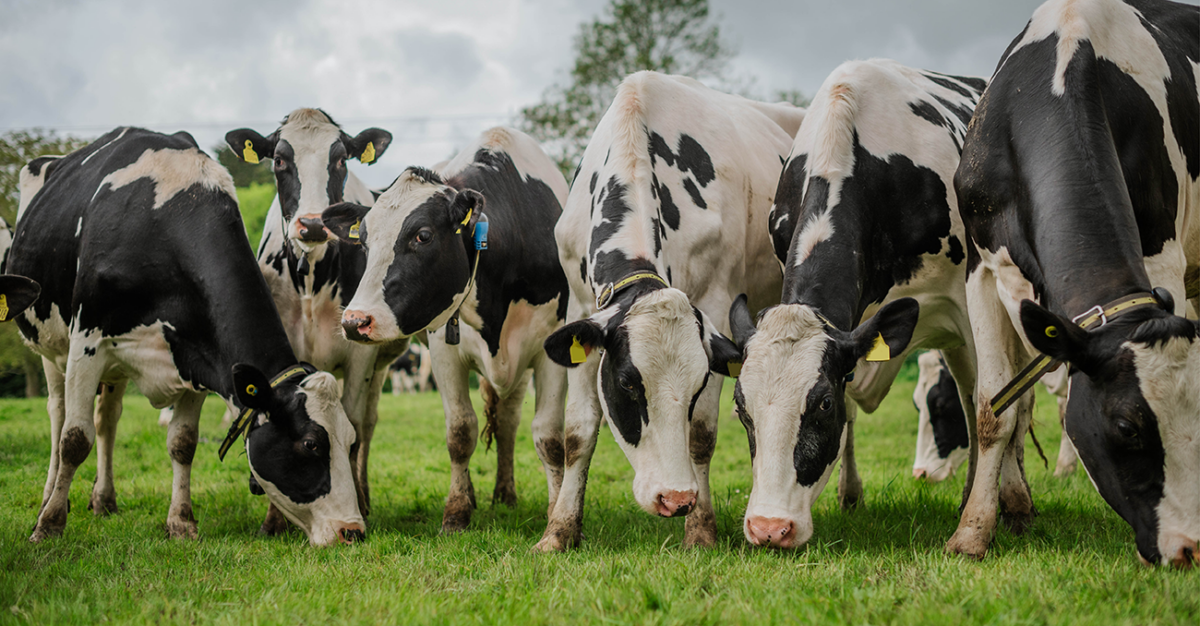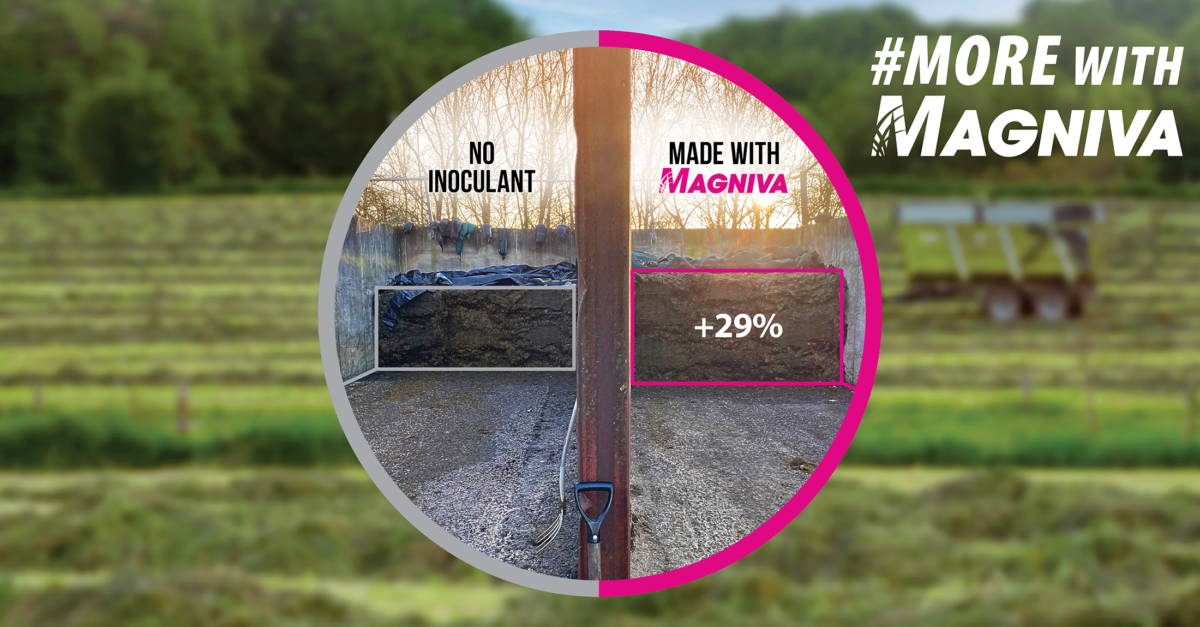Blog | Reading Time 6 minutes
How to improve silage quality and maximise milk from forage – choose the right silage inoculant
Silage quality plays a pivotal role in milk production, herd health, and farm profitability.
Using a silage inoculant can enhance fermentation, minimise dry matter losses, and improve forage digestibility.
But with a variety of silage inoculant products available, choosing the right one for your system is essential.
Here, common questions on inoculants are answered to help you decide.

What are silage inoculants and why use them?
Silage inoculants (such as those in the MAGNIVA range) introduce beneficial lactic acid bacteria (LAB) into grass silage and other ensiled crops.
These microbes accelerate fermentation, ensuring a faster pH drop, which helps preserve nutrients and prevent spoilage.
While a small amount of LAB occurs naturally in forage, they are often not the dominant bacteria, leading to slower, less effective fermentation.
By applying a forage inoculant, producers can reduce the risk of nutrient losses, maintain silage dry matter, and improve palatability.
This is particularly important for maximising milk from forage and ensuring a consistent, high-quality feed source throughout the year.
What are the different types of microbes used in silage inoculants?
Two types of LAB are used in silage inoculants: homofermentative and heterofermentative bacteria.
Essentially, the homofermenters lock in silage nutrients and the heterofermenters keep them locked in during feedout.
If formulated correctly, a combination of the two can give you the best of both worlds – and it has been shown to increase feedable DM by 29%, and benefit intakes and milk yields1.
What is the difference between homofermentative and heterofermentative bacteria?
1. Homofermentative bacteria
Homofermentative bacteria such as Lactobacillus plantarum work to rapidly convert forage sugars into lactic acid.
This causes a quick pH reduction which preserves silage efficiently, locking in nutrients and reducing ensiling losses.
However, lactic acid can also serve as an energy source for spoilage organisms like yeasts and moulds, potentially leading to losses at feedout.
2. Heterofermentative bacteria
Heterofermentative bacteria like Lentilactobacillus buchneri go beyond lactic acid production, becoming active later in the fermentation.
They convert some of the lactic acid into acetic acid and 1-2 Propanol, which have antifungal properties, helping to inhibit yeasts and moulds.
As well as preventing spoilage during feedout, this makes the silage more stable and helps it hold on to its nutritional value and palatability for longer.
Do inoculants containing heterofermenters cause dry matter (DM) losses?
This question is often raised because heterofermenters create very small amounts of CO2 when producing antifungal compounds.
While this adds an extra stage to the fermentation process, resulting in a small loss of total carbon, it plays a vital role in preventing spoilage.
Even with excellent silage clamp management, without heterofermenters, losses can still occur at feedout or within the total mixed ration (TMR). This can be seen when the TMR heats up.
Any minor dry matter losses from converting lactic acid into acetic acid are more than offset by the benefits of reducing overall DM and energy losses at feedout.
Should an inoculant containing heterofermenters be used for wetter silages?
Generally, the wetter the silage, the more lactic acid needs to be produced to lower the pH effectively. These silages are often prone to overacidification.
In wetter silages, homofermenters are essential for initiating fermentation, rapidly lowering pH through lactic acid production.
Once this phase is complete, heterofermenters help maintain stability during feedout by producing antifungal compounds.
Including heterofermenters as part of a combined inoculant ensures both efficient fermentation upfront, whilst reducing the risk of over acidification by metabolising some lactic acid into the antifungal volatile fatty acids and better protection against spoilage later, keeping silage stable and palatable for longer.
How do enzyme-containing silage inoculants improve fermentation?
Unlike many other options available, several inoculants in the Magniva range contain lignocellulolytic enzymes that enhance microbial activity and improve forage digestibility.
These enzymes break down complex fibre structures, releasing simple sugars that beneficial bacteria use to fuel fermentation.
Using enzyme-containing silage additives can support faster, more efficient fermentation and lead to digestibility benefits in the rumen.
These enzymes unwind grass silage fibres, increasing the number of exposed ends in the fibre which increases surface area available for rumen bacteria, enhancing digestion when fed to cows.
How to select the best silage inoculant for your farm
Choosing the right silage inoculant depends on your specific silage conditions and feedout challenges.

Key factors to consider include weather conditions, silage dry matter (DM) levels, and feeding rates.
In all situations, using the right balance of homofermentative and heterofermentative bacteria is essential to ensure efficient fermentation, stability, and preservation.
For wetter silages (<30% DM):
In wetter conditions, silage is more prone to spoilage due to slower fermentation and a higher risk of undesirable microbial activity.
To counteract this, an inoculant with a mix of homofermenters and heterofermenters is recommended – with a higher concentration of homofermenters.
Homofermenters drive a rapid pH drop and efficient fermentation, which is crucial for stabilising wet silage quickly and minimising nutritional losses.
Heterofermenters still play a role but at a lower concentration, as the primary challenge in wet silage is reducing spoilage caused by unwanted bacteria, rather than yeast and mould growth.
Learn more about our inoculant formulated specifically for wet grass silage, Magniva Platinum Grass Wet.
For drier silages (>30% DM):
Achieving proper compaction is challenging in drier silaging conditions, increasing trapped oxygen risk.
In this situation, a combination of homofermenters and heterofermenters is still recommended – however, heterofermenters play an even more crucial role.
Heterofermenters produce acetic acid, which inhibits spoilage yeasts and moulds, helping to maintain silage stability during storage and feedout.
Find out more about our inoculant designed specifically for dry grass silage: Magniva Platinum Grass Dry.
For slower feedout rates:
Prolonged air exposure increases the risk of spoilage.
The antifungal properties of heterofermenters make them especially valuable for maintaining silage quality and feed value.
Selecting a crop- and condition-specific forage inoculant can help tailor the best solution for farm-specific challenges.
Contact Us
Contact UsReferences:
- Independent trial performed at Centre for Dairy Research, Reading University 2022 (unpublished)
- Forage Centre of Excellence, Miner Institute, New York State (paper pending)
Published Mar 24, 2025 | Updated Mar 25, 2025
